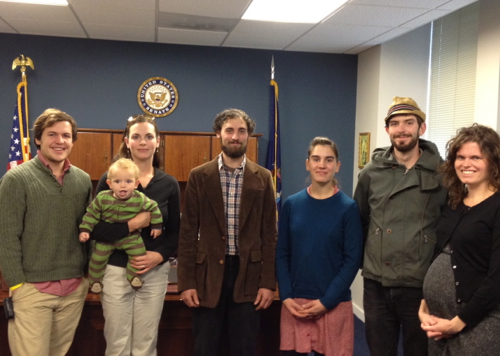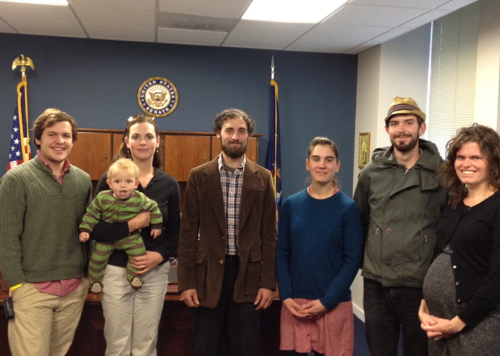 A group of young farmers visiting Sen. Olympia Snowe’s office in Maine.Across the U.S., young people are heeding the call for a more just, sustainable, and healthy food system, and are heading to the fields to build it themselves. They are working on farms and starting their own small-scale farm businesses from scratch. But, as the National Young Farmers’ Coalition recently revealed, there are big obstacles getting in the way of these green entrepreneurs — and the change eaters want to see on their grocery store shelves. Last month, the Coalition released the results of a needs survey of 1,000 young and beginning farmers from across the nation. They also made recommendations for anyone looking to help these farmers succeed. Chief among these recommendations is a set of proposed laws, which would go into effect under the 2012 Farm Bill, called the Beginning Farmer and Rancher Opportunity Act of 2011 [PDF].
A group of young farmers visiting Sen. Olympia Snowe’s office in Maine.Across the U.S., young people are heeding the call for a more just, sustainable, and healthy food system, and are heading to the fields to build it themselves. They are working on farms and starting their own small-scale farm businesses from scratch. But, as the National Young Farmers’ Coalition recently revealed, there are big obstacles getting in the way of these green entrepreneurs — and the change eaters want to see on their grocery store shelves. Last month, the Coalition released the results of a needs survey of 1,000 young and beginning farmers from across the nation. They also made recommendations for anyone looking to help these farmers succeed. Chief among these recommendations is a set of proposed laws, which would go into effect under the 2012 Farm Bill, called the Beginning Farmer and Rancher Opportunity Act of 2011 [PDF].
What exactly did the survey tell us? Not surprisingly, young farmers reported that capital and land access presented the biggest challenges, followed by lack of health insurance. On the flip side, they rated apprenticeships, local partnerships, and community supported agriculture (CSA) as the movement’s greatest assets.
The challenges
The challenge of getting capital into the hands of beginning farmers is closely tied to the types of businesses that they want to create. Lenders, from the USDA’s Farm Service Agency to the cooperative Farm Credit, are now faced with a very different customer. Instead of a few types of businesses with well-known outcomes — i.e. commodity corn or contained animal feeding operations (CAFOs) — these new farmers want to sell dozens of products directly to consumers. The lenders, who once merely had to multiply the price of a bushel of corn by the acreage, struggle to understand the economic possibilities inherent in farmers markets and CSAs. How do you predict a farm’s income, they ask, when it’s not based on the commodity market — and the government guarantees that go with that market?
Rebecca Thistlewaite, who with her husband built a half-million-dollar farm business selling pastured poultry, eggs, pigs, beef, and lambs on rented land near Watsonville, Calif., was one of those new farmers challenging lenders’ assumptions. Needing a permanent farm home to build infrastructure, the couple embarked on a nationwide search for affordable land and eventually found a perfect “turn key operation” just two hours from Minneapolis-St. Paul. The 80-acre farm was complete with a poultry processing facility, a cooler, a freezer, and an affordable price tag.
Knowing that they wouldn’t get far with a traditional lender, they applied to the Farm Service Agency (FSA) for a farm ownership loan. After submitting their 30-page application, including a business plan backed by real numbers from their growing business in California, the couple was turned away. “The FSA didn’t believe it was possible in Minnesota,” Rebecca explains. “They didn’t understand the type of farming that we do.”
Other than questioning their business model, the county FSA office cited a USDA loan rule that farmers must file a “Schedule F,” the IRS tax form for farmers, for three years before qualifying for a farm ownership loan. The FSA’s own manual [PDF] doesn’t require a “Schedule F,” only participation “in the business operations of a farm for at least three years out of the 10 years prior to the date the application is submitted,” but local agents often use the IRS form to determine eligibility. Rebecca and her husband’s two years of Schedule Fs and five years managing other farms weren’t enough for local agents. “This county decided that they were going to stick hard and fast to the rules,” Rebecca recalls. After making one more unsuccessful application to the FSA in California, Rebecca and her husband shuttered their farm business and took other jobs.
The three-year managerial requirement, often misinterpreted by local agents, is just the kind of obstacle that the National Young Farmers’ Coalition is hoping to do away with in the next Farm Bill. We’re advocating for the Beginning Farmer and Rancher Opportunity Act of 2011, which would fix, fund, and continue USDA programs for beginners. The Act was introduced in the fall with bipartisan support in the House by Tim Walz (D-Minn.) and Jeff Fortenberry (R-Neb.), and by a cadre of Democrats in the Senate, led by Tom Harkin (Iowa). Answering to the top needs identified by young and beginning farmers, it’s a long to-do list for USDA and Congress.
The Act includes a microlending program, new provisions that would help farmers find affordable land, and continued priority for beginners in many USDA programs. In addition, the Act would reauthorize mandatory funding for a competitive grant program that enables nonprofits and universities to offer educational and business planning to beginners.
USDA = friend or foe?
This grant program funds the Land Stewardship Project’s “Farm Beginnings” course that helped Josh Reinitz reinvent his family’s Minnesota dairy into East Henderson Farm, a certified organic, 60-member CSA farm in 2009. Josh’s farm, located just a stone’s throw from where Rebecca Thistlewaite attempted to establish her business several years prior, illustrates the potential of the USDA to play a positive role within a changing and often difficult agricultural landscape.
Josh’s father closed their family’s dairy in 1985; he sold off all but 40 acres and took a job off-farm. Despite hard memories and the pursuit of other interests in college, Josh eventually decided he wanted to work the land. After moving back to his hometown from Minneapolis, Josh and his wife began growing a big garden on the family’s property and enrolled in Farm Beginnings to see if they could build a viable business on his family’s remaining acres. After developing a comprehensive farm plan through the class, they launched their CSA in 2009.
Unlike with Rebecca’s experience, the USDA has been a big help in getting Josh’s farm started: The Natural Resources Conservation Service awarded the farm a grant to help him build a season-extending high tunnel, and the FSA just financed the construction of a new vegetable packing shed. Josh found that the agents at his local USDA offices were “not used to working with vegetable farmers,” but he describes them as “open-minded.”
Holistic management
With the Farm Bill process now on restart (after the congressional supercommittee meltdown), the National Young Farmers’ Coalition is taking those like Rebecca and Josh to meet their members of Congress to demonstrate why the nation needs a Farm Bill that is responsive to a changing farm economy. The Coalition is looking to Republican senators who have a growing number of diversified, direct market farms in their states, such as Sen. Olympia Snowe from Maine, to provide needed bipartisan sponsorship for the Beginning Farmer and Rancher Opportunity Act.
With tens of billions of cuts already on the table from supercommittee dealings, an outpouring of support is required to save good programs that are boosting farmers like Josh, and to begin to chip away at the underlying structural issues that are preventing farmers like Rebecca from achieving their potential. Citizens and farmers can help by asking their members of Congress to support the Act to give young farmers the chance of success that they as farmers — and we as a nation — clearly need.



